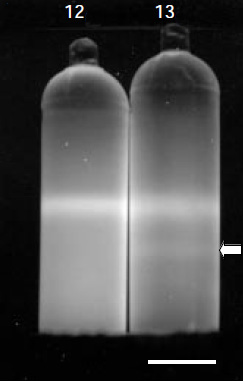Separation of DNA in CsCl gradients
Keywords
Flag Inappropriate
Delete Content

Separation of DNA in CsCl gradients
This photograph is an example of DNA separated in a cesium chloride density gradient. Two tubes containing cesium chloride gradients are arranged vertically next to each other. The gradients have higher densities toward the bottom of the tube and lower densities toward the top of the tube. The solutions contain ethidium bromide, which causes the DNA to appear as fluorescent bands. The tube on the left contains a single horizontal band of DNA, indicating that it has DNA of one density. The tube on the right has two horizontal bands: one band is at the same position in this tube as the band in the tube on the left, and the other band, which has a white arrow pointing to it, is lower in the tube. The lower band contains DNA of a higher density.
This image is linked to the following Scitable pages:
Apicoplasts are organelles that were discovered in parasites like the one that causes malaria. How did scientists discover these organelles, and what do they do?





















Comments
CloseComments
Please Post Your Comment